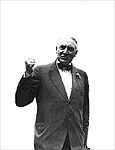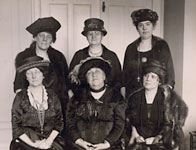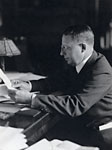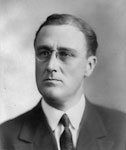| From War to Normalcy: Introduction | World War I | The Presidential Election of 1920 |
| The Presidential Election of 1920 |
| Speakers: Warren Harding | Calvin Coolidge | Corinne Roosevelt Robinson | James Cox | Franklin D. Roosevelt |
|
By 1920, World War I was over. The wartime boom had collapsed. Diplomats and politicians were arguing over peace treaties and the question of America's entry into the League of Nations. Overseas there were wars and revolutions; at home there were strikes, riots and a growing fear of radicals and terrorists. Disillusionment was in the air. The giants who had dominated the political scene for a generation were gone -- Theodore Roosevelt died in 1919 and Woodrow Wilson was a broken invalid living in seclusion. Even so, the presidential election of 1920 continued the debate between the nationalistic activism of Roosevelt's presidency and the global idealism of Wilson's administration. On June 8, 1920, the Republicans nominated Warren G. Harding, an Ohio newspaper editor and United States Senator, to run for president with Calvin Coolidge, governor of Massachusetts, as his running mate. The Democrats nominated another newspaper editor from Ohio, Governor James M. Cox, as their presidential candidate, and thirty-seven-year-old Franklin Delano Roosevelt for vice president. The presidential election of 1920 was the last election campaign made accessible to the public solely through the use of record albums. By election night -- November 2, 1920 -- the "election campaign by phonograph" was a thing of the past, superseded by the first commercial radio broadcast coverage of election returns. |
| Warren G. Harding, Republican Candidate for President |
|
Warren Harding, publisher and editor of the Ohio Marion Star, was active in politics throughout his life. He served as an Ohio state Senator (1900-1904), as Lieutenant Governor of Ohio (1904-1906), and as a United States Senator (1915-1921). While Harding was serving in the Senate, the Republican party nominated him as their presidential candidate for the election of 1920. Harding's campaign promised a return to "normalcy," rejecting the activism of Theodore Roosevelt and the idealism of Woodrow Wilson. Voters responded to his genial nature, impressive stature, and bland message; he won by a landslide. Harding recorded several speeches for the Nation's Forum. The speech featured here is the most notable of his campaign, containing his famous plea for normalcy: "America's present need is not heroics but healing; not nostrums but normalcy; not revolution but restoration...not surgery but serenity." Audio Selection: "Readjustment." Warren Gamaliel Harding (1865-1923). |

[Warren G. Harding, half-length portrait, facing front, standing, gesturing with right fist clenched and raised]. Photograph by National Photo Company, [between 1921 and 1923]. Library of Congress, Prints and Photographs Division. Reproduction Number: LC-F8-8562. |
| Calvin Coolidge, Republican Candidate for Vice-President |

Calvin Coolidge, three-quarter length portrait, seated, facing right. Photograph by Notman Photo Co., Boston, Mass., c1919. Library of Congress, Prints and Photographs Division. Call Number: PRES FILE-Coolidge, Calvin-Photographs-Three-Quarter. |
Governor Calvin Coolidge of Massachusetts first achieved national prominence during the Boston police strike of 1919, when he sent a telegram to Samuel Gompers, President of the American Federation of Labor, saying: "There is no right to strike against the public safety by anyone, anywhere, any time." Coolidge was a reserved, uncommunicative New Englander; writer and wit Dorothy Parker once remarked he looked as though he had been "weaned on a pickle." Even so, his obvious integrity and the simple American values he espoused soon made "Silent Cal" a popular figure. He succeeded to the presidency upon Harding's death in 1923, and was elected to the White House in his own right in 1924. Brief Audio Selection: Law and Order. Calvin Coolidge (1872-1933). |
| Corinne Roosevelt Robinson, Prominent Republican, Sister of Theodore Roosevelt |
|
Corinne Roosevelt Robinson was a frequent participant in charities and politics. Active in both the Red Cross and the Salvation Army, she was also a member of the executive committee for the Republican National Committee, and the Republican New York State Committee. A well-known Republican in New York, Corinne Robinson's importance grew because the presidential campaign of 1920 marked the first election in which women could vote. Anxious to attract women's votes, both the Republican and Democratic parties sought significant women to speak in support of their candidates. In the speech she recorded for the Nation's Forum, Robinson speaks of her support for the Republican candidates because they are "one hundred percent American." Audio Selection: Safeguard America! Corinne Roosevelt Robinson (1861-1933). |
 Famous G.O.P women arrive [Corinne Roosevelt Robinson in upper left hand corner]. Photograph by Underwood & Underwood, c1921. Call Number: BIOG FILE-Roosevelt, Mrs. Corrine.
Famous G.O.P women arrive [Corinne Roosevelt Robinson in upper left hand corner]. Photograph by Underwood & Underwood, c1921. Call Number: BIOG FILE-Roosevelt, Mrs. Corrine.
|
| James M. Cox, Democratic Candidate for President |

[James Cox, Governor of Ohio, half-length portrait, facing left, seated at desk, reading]. Photograph by Lucia A. Weeks, c1920. Library of Congress, Prints and Photographs Division. Call Number: BIOG FILE-Cox, James M., 1870-1957. |
James Cox practiced a variety of trades throughout his life: high school teacher, reporter, owner and editor of several newspapers, and secretary to Congressman Paul Sorg. Cox represented Ohio in the United States House of Representatives (1909-1913), resigning after winning election as Governor of Ohio (1913-1915, and 1917-1921). He was nominated a candidate for the presidency by the Democratic party while serving as Governor. Cox recorded for the Nation's Forum several times. The campaign speech featured here accuses the Republicans of failing to acknowledge that President Wilson's successful prosecution of the war had, according to Cox, saved "civilization." Audio Selection: The World War. James Middleton Cox (1870-1957). |
| Franklin D. Roosevelt, Democratic Candidate for Vice-President |
|
A Harvard graduate (1904) like his distant cousin Theodore, Franklin Roosevelt began his political career as a member of the New York state Senate (1910-1913), where he made a name for himself battling "Tammany Hall," the New York City political machine. His efforts in Woodrow Wilson's 1912 presidential campaign led Wilson to appoint him Assistant Secretary of the Navy (1913-1920), a position which Roosevelt kept throughout World War I. Many thought the thirty-eight-year-old vice presidential candidate was immature; Senator Henry Cabot Lodge described him as "a well-meaning, nice young fellow, but light...." In the speech he recorded for the Nation's Forum, Roosevelt spoke of World War I, promising those who fell in battle that "it shall not occur again. Americans demand: The crime of war shall cease" -- ironic words from the man who was to lead the nation during World War II. Audio Selection: Americanism. Franklin Delano Roosevelt (1882-1945). |

[Franklin Delano Roosevelt, head-and-shoulders portrait, facing slightly left]. Photographer unknown, c1920. Library of Congress, Prints and Photographs Division. Reproduction Number: LC-USZ62-11190. |
| From War to Normalcy: Introduction | World War I | The Presidential Election of 1920 |